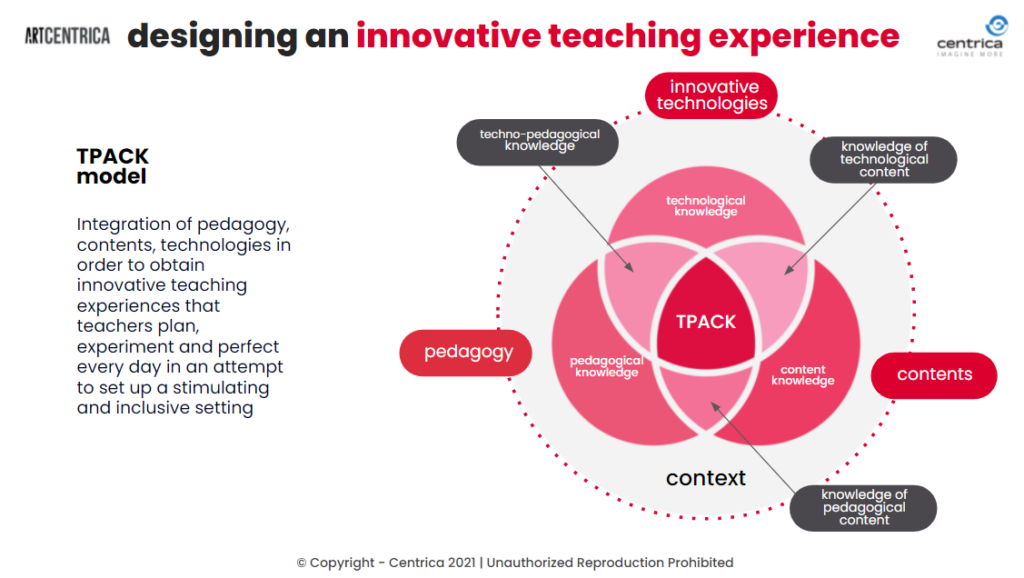ArtCentrica
10 January 2022
ArtCentrica Webinar: how to design an innovative teaching experience
High school / University
As you know having read our newsletter, we have been chosen to being part in the accelerator program IMPACT EdTech, which promotes state-of-the-art solutions for the future of Education Technology.
We have worked hard these past months putting together activities and efficient strategies to achieve success in those objectives; from these initiatives we produced a series of webinars for Italian high-school teachers to whom we presented not only our cloud application ArtCentrica but also underlined the positive aspects of an innovative didactic experience. Importantly teachers were able to field test the program creating lessons ad hoc on specific subects inherent to Art History.
This experience has been extremely favorable for us in that it has allowed us to demonstrate the real-world effectiveness and potential of our platform as well as indicating the specifics that need changing and/or improving. The feedback from teachers, including their questions and their interest in ArtCentrica, has been a precious exchange of understand giving proof that a rich exchange is possible between the Technological sector and the world of Education.

Webinars have had at their core, as planned, the innovative learning experience and the positive learning basis which it can give students in their scolastic pursuits. It has been mentioned that “active learning” in contrast to the traditional learning path is able to put students on a path to learn with less difficulty thanks, in great part, to the use of digital tools.
These are the fundamental characteristics of the innovative learning process:
- Student-centered processes
- Active student participation
- Valorization of the opportunities offered by the digital world
- Improvement of the learning experience
- Activation of qualified strategies for the rating of the learning material
- Promotion of the creative potential of each and every student
Digital platforms such as ArtCentrica contribute productively to modify the teacher-orator paradigm. In general the teacher-orator personally choses the lessons content, presenting the material in the most efficient manner, which can allow for an overly verbose presentation. In deep contrast teachers who use technical instruments to complement their lessons are considered “designer docents” and are inherently more inclined to prepare more encompassing lessons that are designed for easy exchanges of opinion and easier sharing between teachers and students and, more importantly, these instruments allow for the creation of a context which favors the fulfillment of established academic goals.
TPACK model
In that vein reference has been made to the TPACK model, which integrates the pedagogical method with content material, and technology, with the intent of providing an innovative learning experience which teachers can program, experiment with, and perfect every day, with the goal of furnishing a stimulating and inclusive educational setting.

Specifically, the teaching of Art History favors a didattic approach of the holistic type, which encourages the student to develop a set of soft-skills:
- Independent critical thinking
- Curiosity
- Immagination
- Interdisciplinary skills
Thanks to ArtCentrica teachers can integrate their lessons with online reference material as well as make use of annotations to provide in-depth detail of the works of Art which can be viewed and shared by others on-line as resources to augment the quality of the lesson thus stimulating an approach to learning and studying Art that encourages the acquisition of soft-skills.
So what are and to what use are the annotations?
Here are a series of points to help understand their presence:
- They provide additional detailed information for the Artwork
- They encourage the participation by the student in the editing of comments/annotations (also for
a quality assesment) - They give an indication of associated interdisciplinary subject matter
- They indicate a specific bibliography tied to, a specific individual, a detail in an Atrwork, a place
shown in the Artwork.
Webinar serves to underline, once again, how the core STEM areas (Science, Technology, Engineering, Math) are not by themselves equipped to serve the Education community but require the integration of Art (STEAM) to develop a fully integrated learning system repleat with critical thinking.
Hi-Res Artwork on ArtCentrica Platform:
Bibliography:
Brambilla F., Casiraghi D., Marenghi P., Sancassani S., Progettare l’innovazione didattica, Pearson Academy, 2019
